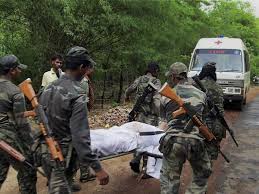 Raipur, May 27: In wake of the deadly Maoist attack on the Congress Parivartan rally in Chhattishgarh, more than 1,000 security personnel have been pumped into the jungles of the Naxalite-infested Bastar region for a major offensive against the ultras.
Raipur, May 27: In wake of the deadly Maoist attack on the Congress Parivartan rally in Chhattishgarh, more than 1,000 security personnel have been pumped into the jungles of the Naxalite-infested Bastar region for a major offensive against the ultras."Over thousand security men are on a combing operation in the region (Bastar) after the attack on Congress leaders," director general of police Ramniwas told on Monday.
Heavily armed Maoists ambushed a convoy of Congress leaders in Chhattisgarh's Bastar district on Saturday, killing 27 people including state Congress chief Nand Kumar Patel, senior leader Mahendra Karma and ex-MLA Uday Mudliyar besides leaving 36 others injured including former Union minister VC Shukla.
DGP Ramniwas said they have received a tip-off about the cadres who orchestrated the attack and assured early action.
"We have got input about the Naxalite leaders, who were involved in the attack and efforts are on to nab them," he said.
On the missing security personnel, the DGP said, "A police jawan Pawan Kindro is missing and search is on for him in the jungles."
According to police sources, so far security forces have recovered 24 bodies from Jiram valley of Darbha block where attack had taken place.
Meanwhile, a team of NIA (National Investigation Agency) has reached Raipur and begun its probe into the incident.
"The NIA team has reached here and started investigation at its level," the DGP added.





Comments
Add new comment